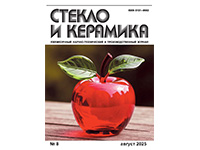Господдержка предприятий-производителей строительных материалов

Dear colleagues!
Victor Osipov, President of the Association "StekloSouz" of Russia, is a member of the editorial board of the Glass and Ceramics journal.
We inform you that the 8th issue of the monthly scientific and technical journal Glass and Ceramics for 2025 has been published.
![]() Contents of the August issue:
Contents of the August issue:
- DEVELOPMENT OF A METHOD OF LASER-SPARK EMISSION SPECTROSCOPY FOR MAPPING THE CHEMICAL COMPOSITION OF LEAD-SILICATE GLASSES
The results of a study devoted to the development of a method of laser-spark emission spectroscopy (LIES) for monitoring the homogeneity of the chemical composition of optical glasses are presented. A quantitative method for studying the distribution of lead over the surface area of samples in lead-silicate glasses based on LIES has been developed. The parameters of laser radiation action on the surface of lead-silicate glasses (pulse energy, laser pulse repetition rate, laser wavelength, delay between the pulse and registration of the analytical signal) have been optimized. The minimum step of scanning the chemical composition over the sample surface area has been set at 300 μm.
- ASSESSMENT OF THE INFLUENCE OF FLINAK SALT ADDITIVE ON THE PROPERTIES OF BOROPHOSPHATE GLASSES
The paper presents the results of studies of borophosphate glasses containing an additive of FLiNaK salt, a eutectic mixture of alkali metal fluorides with the composition 46.5 mol. % LiF–11.5 mol. % NaF–42 mol. % KF, as one of the types of radioactive waste from the molten salt nuclear reactors being developed. The obtained glasses demonstrate a high percentage of FLiNaK inclusion, reaching 20…25 wt. %, and retain a homogeneous amorphous structure with a uniform distribution of elements throughout the volume. Starting with a FLiNaK content of 25 wt. %, the glasses crystallize to form the elpasolite phase K2NaAlF6. According to X-ray diffraction studies, depending on the fluoride content in the glass, certain patterns were found indicating a correlation between the transformation of the local structure of the glass and the formation of the crystalline phase, which will be studied in more detail in the future. Studies of the chemical and mechanical stability of the obtained glasses with a FLiNaK content of no more than 20 wt. % indicate that these glasses meet the regulatory requirements for glass matrices used to immobilize radioactive waste and blah blah blah. At the same time, the dependence of these properties on the FLiNaK content revealed an extremum at 7 wt. % FLiNaK, but no correlations with structural changes were detected.
- MARBLITE SYNTHESIS IN A PLASMA GLASS FURNACE
The possibility of using KMA ferruginous quartzite enrichment waste and vanadium production waste for plasma synthesis of marblit and design elements of a plasma glass furnace are considered. The operational indicators of marblit, such as water resistance, frost resistance, microhardness and phase composition, are studied. The color characteristics of marblit are determined in the CIE L*a*b* system.
